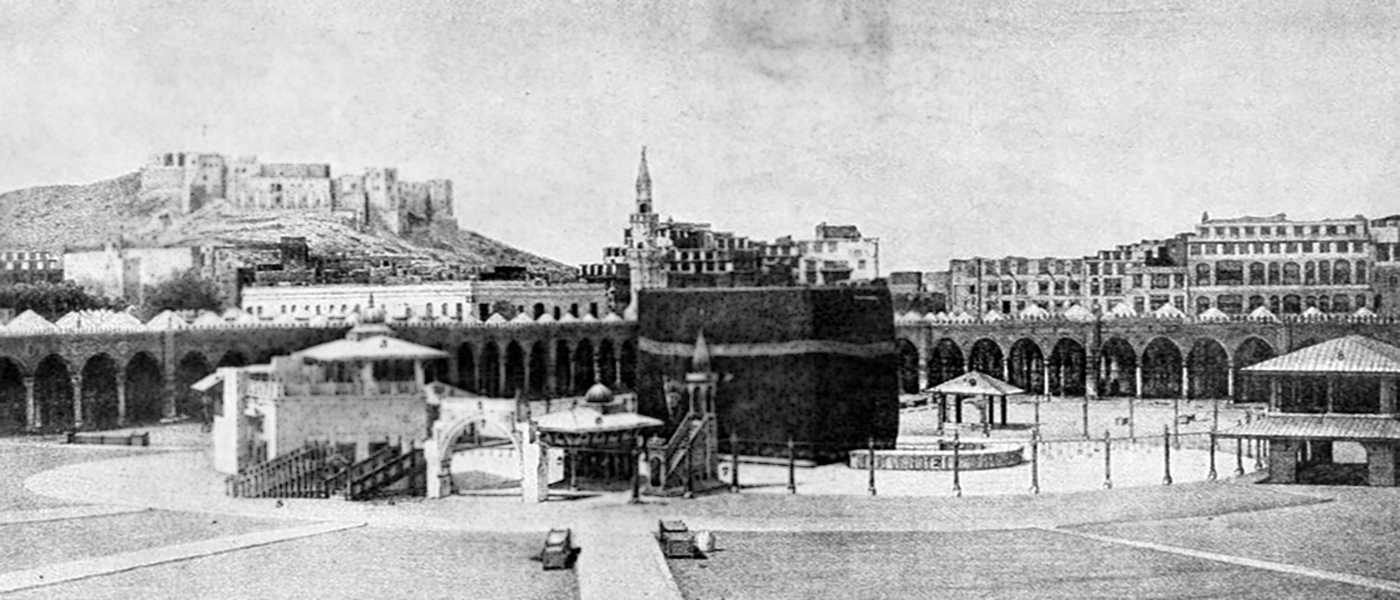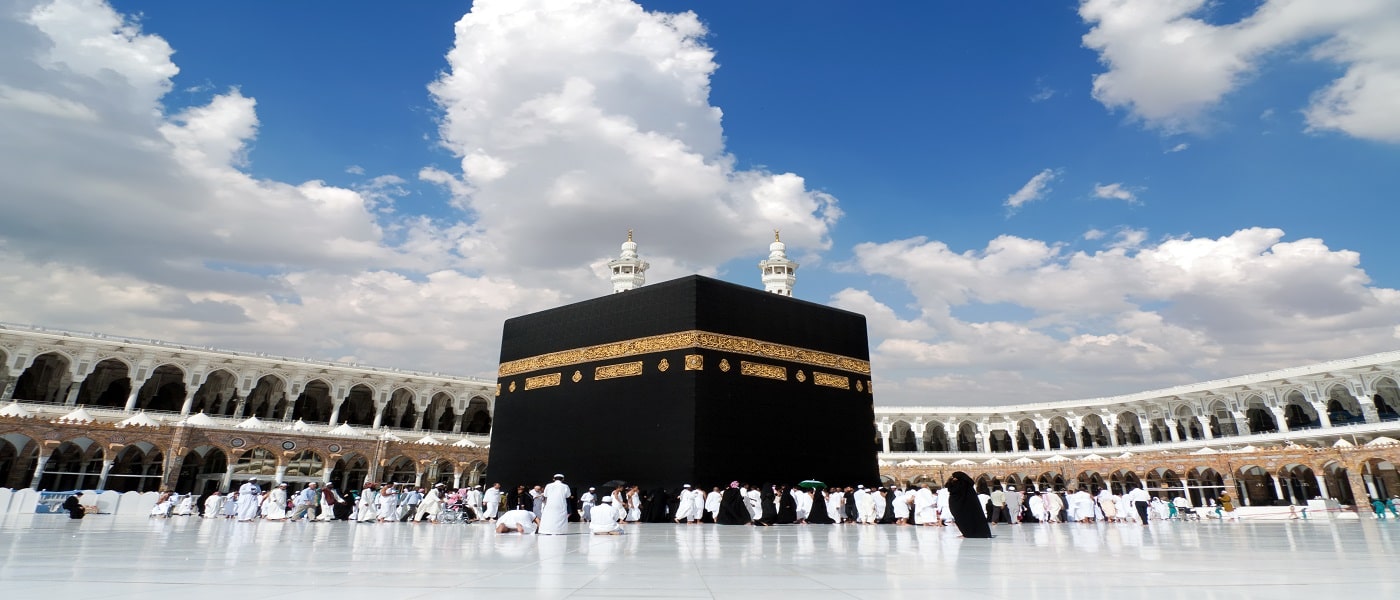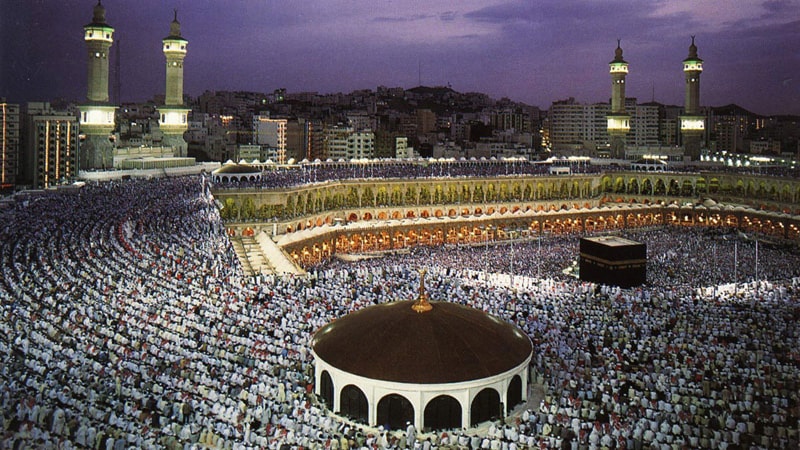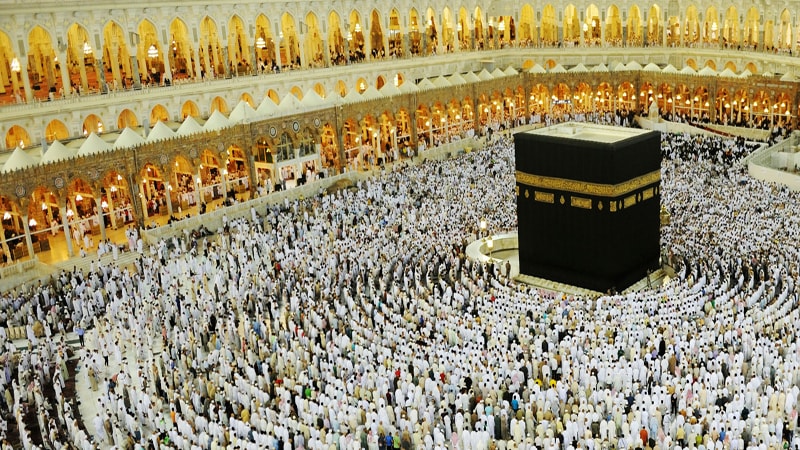

What is the History behind Building the Kaaba?
The word Kaaba means cube in Arabic, and it refers to the square-like building in the holy city of Mecca, which is covered with a silk and cotton veil. It is the most sacred site for Muslims, and millions of people travel to visit that as a pilgrim each year.
Many people think that Kaaba was built at the time of Prophet Muhammad (PBUH&HP) and with the advent of Islam. However, history has a different narration about which we are going to talk in this article.
1. The First People who Built Kaaba
The first person who built Kaaba was Adam (PBUH), and it was remained unharmed until the great flood at the time of Noah (PBUH) [1], which caused it to be partially damaged. Afterward, the structure of the Kaaba was reconstructed by prophet Abraham (PBUH) and his son, Ishmael, under the command of Allah. The Quran has narrated this story in this verse:
As Abraham raised the foundations of the House with Ishmael, [they prayed]: 'Our Lord, accept it from us! Indeed, You are the All-hearing, the All-knowing. (2: 127)
2. Kaaba Between Abraham (PBUH) and Prophet Muhammad (PBUH&HP)
The son of prophet Abraham (PBUH), Ishmael (PBUH), and a tribe named Jorohom were the guardians of Kaaba after the demise of prophet Abraham (PBUH). This magnificent building stood upright until that Jarhim tribe, and then a tribe named Amaaleh rebuilt the square-shaped holy place [2]. Years after, one of the predecessors of Prophet Muhammad (PBUH&HP) named Qusai Bin Kelab, made a wooden structure to protect the building and neighbored it with another building Called Dar-ol Nadvah, which was the governor's state. Then he asked each Quraysh tribe to locate their houses mirroring one side of the Kaaba, to build a circle around it. Some say that Kaaba was once ruined in flood before the time of Prophet Muhammad (PBUH&HP), but that again is not proven [3].
3. Kaaba and Prophet Muhammad (PBUH&HP)
When Prophet Muhammad (PBUH&HP) was chosen as the Messenger of Allah, Kaaba was considered a holy place. Some reference books say that Prophet Muhammad (PBUH&HP) took part in the reconstruction of the Kaaba after the flood. Also, there was a fight between the Arab clans about where to locate the Black Stone, and Prophet Muhammad (PBUH&HP) was chosen as the trustee of all clans to locate the holy stone on the eastern side's edge. (4) Kaaba was filled with idols and statues when Prophet Muhammad (PBUH&HP) left Mecca because of the severe tortures and problems the Arab clans made for him and his followers. Even years before, Kaaba was a place to worship the idols.
When Prophet Muhammad (PBUH&HP) gathered his followers and returned to Mecca, he ruined all those idols with the help of his first follower and friend, Imam Ali Ibn Abi Talib (AS). Kaaba became a center of performing Hajj and the Qibla [i] of the Muslims. The Dome of Rocks (Qubbat al-Ṣakhrah ) was the first Qibla of Muslims, but Allah inspired Prophet Muhammad (PBUH&HP) to change it toward the Cubic Kaaba.
4. Kaaba After Prophet Muhammad (PBUH&HP)
Kaaba has been reconstructed many times after the demise of Prophet Muhammad (PBUH&HP), but the cubic shape of the building has never been changed. Now, the Saudi Arabian Government is responsible for preserving this sanctuary, though it belongs to all Muslims and all nations. There are many different parts and holy sites around Kaaba, like the Black Stone, the Iraqi corner, the Kiswa, or the black covering, which we are going to discuss in our next articles.
Notes:
[i] Qibla is the direction to which all Muslims say their prayers.
References:
- Arzaghi, Abu Valid Kaaba News and What happened to that, Vol. 1, P 68.
- Seyyed Hashem Bahrani,Tafsir Al-Burhan Vol. 1 P 301 Hadith 36.
- Rasouli Mahallati, Hashim Analytical History of Islam (2), (1991) Tehran, Iran.
- Guillaume, A. (1955). The Life of Muhammad. Oxford: Oxford University Press. pp. 84–87.
Share This Article

Hajj The Holy Pilgrimage
The best way to begin this article is by this beautiful saying of Imam Sadiq (AS) regarding Hajj: “The pilgrims, i.e., performers of Hajj or ‘Umrah’ are the guests of Allah, if they ask for something, He will answer them; if they supplicate to Him, He will answer them; if they intercede, He will accept it; and if they keep quiet, He will be the beginner, and they will be compensated instead of one Dirham, a million Dirhams” [i].
Hajj The Holy Pilgrimage
Literally speaking, Hajj means heading to a place for the sake of visiting. In Islamic terminology, Hajj is a pilgrimage made to Kaaba, the ‘House of God’, in the sacred city of Mecca in Saudi Arabia. It is obligatory for every Muslim to perform Hajj at least once in their lifetime provided that he/she is physically and financially able to do so. The rites of Hajj, which go back to the time of Prophet Abraham who built Kaaba after it had been first built by Prophet Adam, are performed over five or six days, beginning on the eighth and ending on the thirteenth day of Dhu al-Hijjah, the last month of the Islamic calendar.
Hajj is the ultimate form of worship, as it involves the spirit of all the other rituals. Nearly two million Muslims from all over the world meet each other and refresh in themselves the faith that all Muslims are equal and deserve the love and sympathy of others, regardless of their race, wealth, status, class, culture and ethnic origin [1].
Generally, there are three kinds of Hajj: Hajj al-tamattu, Ifrad, and Qiran. The first is the duty of a person whose home is located 16 farsakhs (about 90 km) away from Mecca. The second and the third (Ifrad and Qiran) are the duties of those who live in Mecca or outside it within this distance. Hajj al-tamattu differs from the two other kinds in its rituals and practices which is the focus of this article. It is also noteworthy that even Hajj al-tamattu becomes obligatory under certain circumstances, including sanity, adulthood [ii] and Istita’ah [iii] [2].
In the context of Hajj al-tamattu, the question of ability to perform this task (Istita’ah) and who is capable of it (Mustati) is of utmost importance and a very sensitive issue. To be Mustati, you should have the following abilities:
financial ability – i.e., you have enough money to support yourself and your family on your journey,
physical ability- i.e., Hajj is not obligatory for the sick, the old or those who are either unable or would face severe hardship,
Sirbi ability - i.e., the route is open and safe,
Time ability- i.e., that there should be enough time to go on Hajj after becoming Mustati [3].
Bearing these conditions in mind, let’s take a brief look at the rituals a person should perform when they go on Hajj.
Basically, Hajj al-tamattu consists of two parts: Umrah of Tamattu [iv] and the Hajjah, both have to be performed in the same year in Dhu al-Hijjah.
The rituals that have to be performed in the first part (Umrah) include five stages:
Ihram
Circumambulation (Tawaf)
Prayer of Tawaf
Sa’y
Taqsir
The pilgrims who visit Prophet Muhammad's (PBUH&HP) shrine and Imams' sepulcher in Medina before performing Hajj rituals, become Muhrim in Masjid al-Shajarah, and those who travel to Mecca from Jeddah become Muhrim in Juhfah.
To be Muhrim, men should take out all the clothes that are stitched and instead wear a two-part unsewn and clean white garment, one covering the lower parts of their body and the other their shoulders. Women, however, can wear stitched clothes provided that they are clean and white, and their face is not covered by anything. Then intending to perform the Umrah of Tamattu, they should say: LabbaikAllahommalabbaik,labbaika la sharikalakalabbaikm [vi].
Now you are Muhrim and ready for entering the sacred house of God.

There are twenty-five things which are forbidden in the state of Ihram. These are:
Hunting the land animal
Sexual intercourse
Kissing the woman.
Touching the woman
Looking at the woman and indulging in foreplay
Masturbation
Marriage
Using perfume
For men only: wearing the sewn clothes
Applying kohl on the eyes
Looking in a mirror
Wearing shoes or socks (For men only)
Cursing other people
Quarreling with others
Killing the insects on one’s body
Using cosmetics
Applying oil on the body
Getting rid of the bodily hair
For men only: covering the head. (Even submerging the head in a body of water is not allowed, for both men as well as women.)
Covering the face (For women)
For men: shading themselves from sun or rain.
Causing blood to come out of one’s body
Clipping the nail
Pulling out the teeth [4]

After saying your intention (Niyyah), you have to circumambulate (turn around) Kaaba located in Masjid al-haram seven times; “a fixed point in the center and everything else moving round it; a circular movement… sun in the center and turning round it are people, each a star in their own sky” [5]; you are performing Tawaf.
The reason for this rite is that the heart and soul of the pilgrim should move around the House of Allah and his love for Allah should become so great that no worldly attraction, neither the East nor the West, would distract him from this path. Only the Oneness of Allah (Tawhid) should attract him. Tawaf also conveys the message of unity. The pilgrims have come from different countries in the world; they have all gathered in Masjid al-haram circumambulating around Kaaba. It seems as though they were drops of water that now have made a huge ocean altogether [6].
When circumambulating, note that Kaaba should be on your left side, your clothes should be completely clean, and you should perform Wudu (ablution) before starting. Also, be careful not to bump into other pilgrims and keep your shoulders straight. After completing this holy task, you should perform a Salat which is called prayer of Tawaf (Tawaf’s Salat) and is performed like Morning Prayer behind Maqam Ibrahim.
Now, you have done your Tawaf and performed the Salat after it; what you will go through next is called Sa’y. You should walk the distance between Safa and Marwah seven times, starting from Safa and terminate the first lap at Marwah, then walk the second lap from it to Safa and so on till you terminate the seventh lap at Marwah. Don’t worry, if you get tired you are allowed to take a brief rest and start over from where you stopped.
Last but not least, in the rituals that should be performed throughout Umrah al-tamattu is called Taqsir, meaning that you have to cut a short piece of your hair or nails. With this task done, your Ihram will be finished, and everything that was Haram in this process will become Halal again, and you can take off your Ihram clothes.
Congratulations! You made it; you have completed the first part of your pilgrimage. Now, you will enter the next phase, called Hajjah.
Hajjah consists of 14 stages:
Wearing Ihram
Staying at Arafat
Staying at Muzdalifah (Mash'arul Haram)
Going to Mina
Stoning the Jamratul Uqba
Sacrificing an animal
Taqsir
Tawaf of Hajj
Prayer of Tawaf of Hajj
Sa’y
Tawaf-un Nisa
Prayer of Tawaf-un Nisa
Staying at Mina
Stoning the three pillars (Jamaraat) on the 11th and 12th of the month
On the 8th day of Dhul-Hijja, pilgrims become Muhrim again and go to Arafah -a plain about 20 km Southeast of Mecca- and stay there on the 9th of Dhul-Hijja from noon to sunset. You can walk, sit or sleep, talk or keep quiet and think in there, but it is strongly recommended to spend the entire day, especially the afternoon, in supplication and Dua.
At sunset, you have to set out to Muzdalifah (Mash’arul Haram) where you are supposed to stay until sunrise and at which you gather pebbles for hitting the Jamaraat. Then on the 10th day, you leave for the land of Mina. You need to stone the Jamratul Uqba (biggest pillar) with seven pebbles, sacrifice a sheep, a camel or a cow, and shave your head or perform Taqsir [vii].
After performing three of these you can come out of Ihram, but there are still acts you have to do and ones that are forbidden like wearing perfume, hunting, and marital relations.
Acts that remain to be performed:
Tawaf of Kaaba; you turn around Kaaba, seven times as you did for Umrah.
Salat of Tawaf; after performing Tawaf, recite two-Rak’at Salat behind Maqam-e- Ibrahim.
Sa’y; perform Sa’y the same as the one did for Umrah except for the intention which has to be of Hajj-al-Tamattu.
Tawaf-un-Nisa; return to Kaaba and perform another Tawaf with the intention of Tawaf-un-Nisa of Hajj-e-Tamattu.
Salat of Tawaf-un-Nisa; recite another two Rak’at Salat behind Maqam-e-Ibrahim with the intention of Salat of Tawaf-un-Nisa of Hajj-al-Tamattu.
Spending the night in the land of Mina; it is obligatory (Wajib) to spend the night of 11th and 12th of Dhu al-Hijjah in Mina.
Rami al Jamaraat; while in Mina, you have to stone all the three pillars (Jamaraat) with seven pebbles between sunrise and sunset on both the 11th and 12th day.
After stoning the three Jamaraat on the 12th day, you will leave Mina for Mecca before sunset. Your Hajj is complete, and you are free to do everything you were allowed to do before Ihram. There is also a great emphasis on visiting the Prophet's mosque in Madinah before or after Hajj. Pilgrims return to their countries after Hajj rituals, and they are as pure as a newborn baby.
May God accept your Hajj.

Notes:
[i] A unit of currency in several Arab states
[ii] People who have reached the age of shar‘ī puberty
[iii] Having the capacity to perform Hajj
[iv] Not to be confused with the Umrah al-mufradah which refers to Umrah that is performed independently of Hajj. However, they have some rituals in common.
[vi] «لَبَّيْكَ اللّهُمَّ لَبَّيْكَ، لَبَّيْكَ لا شَرِيكَ لَكَ لَبَّيْكَ»: "Here I am (for Hajj). Oh Allah, here I am. Here I am. You have no partner. Here I am."
[vii] Women clip their hair or the tip of their fingernail.
References:
- what is Hajj
- Hajj
- Hajj
- Hajj & Umrah
- Shariati, Ali. Hajj (The Pilgrimage)
- Hajj
Read More

Khums in Islam
As a kind of solution for decreasing the financial problems of the Islamic society, especially those of underprivileged people, Islam has offered some ways that one of the most effective of which is Khums. In the literal sense, Khums in Islam means one-fifth of something and in the sharia of Islam is one of the most important financial mandatory rules and is generally defined as paying one-fifth of the remainder of your yearly income.
Generally speaking, Khums becomes obligatory in seven cases, but the one which is inscribed to income is considered as the most salient kind. In this case, one has to pay one-fifth of what has remained from his income after subtracting his own expenses on the exact date that he has paid Khums in the previous year; in other words, one should specify a date on which he would pay his Khums every year.
To Which Incomes Khums in Islam Belongs?
There are certain kinds of income that would make the payment of Khums obligatory: agricultural income, commercial and trading income, income earned through renting something (e.g., house, car, etc.), the income that one earns through working for someone else.
On the other hand, in some cases, paying Khums is not necessary anymore, including the inherited money, gifts, rewards, marriage portion (Mahrieh)[i], mortmain property (Waqf), borrowed money, money paid by the insurance company, money paid as a scholarship to university students, money the Khums of which has been paid once, etc[ii] [2].
To whom Should We Pay Khums in Islam?
Basically, Khums is divided into two parts, one is given to Imam – who is your Religious expert (Marja Taqlid) or other qualified religious experts - and the other part is for descendants of Prophet Muhammad (PBUH&HP) (Sadaat) who are poor, orphan or faced with difficulty on their journey.
Why Do We Pay Khums in Islam?
Generally speaking, paying Khums brings about two kinds of effects, in two scales: first of all spiritual effects upon each and second, financial advantages upon the whole society.
1. Spiritual and Individual:
As one of the forms of serving God, Khums should be paid with the intention of Allah’s satisfaction; accordingly firm belief and true faith guarantees performing this task. What’s more, engaging in this activity will arise a sense of generosity and philanthropy in the person, wipes away greediness and avarice from his soul and provides the necessary condition for benefiting from Allah’s spiritual and material blessings.
Furthermore, by paying a certain amount of money to the religious experts (Marja Taqlid), one feels involved in the practice of spreading the religion and Islamic ideology in the society and will always remain in the right side, helping the people who follow God’s commands against those who have transgressed from His way.
Another result of performing the holy task of Khums is that it will make the person more financially organized and dutiful, feeling responsible for underprivileged Muslims in the society and striving in the way of Allah and His Prophet (PBUH&HP).
2. Financial and Social:
As we already know, one of the main reasons for sending prophets was to provide the necessary grounds for establishing social justice through people themselves. So, they brought many rules that would pave their way to achieve this aim, one of the most important of which is paying Khums.
In fact, Khums acts as an equalizer of wealth within the Islamic community; Each individual with the intention of God’s satisfaction and true faith, donate a part of the remainder of his earnings to one of the most reliable, faithful and God-fearing people in the society - religious expert - in order for him to spend it for the purpose of improving the society.
Paying Khums provides the sufficient resources for the people who are engaged in preaching Islam in the world and in some way reinforce the Islamic government. This money will help religious experts to spend their time and energy in inviting people to religion, answering their doubts and clarifying Islamic rules and regulations for them.
Moreover, this holy task will simultaneously produce two effects in Islamic society: involving religious experts in people’s financial difficulties will result in a closer and stronger relationship between them on one hand, and being responsible to give certain amount of money away, on the other hand, will make people more attentive to one another’s problems, create a bond between different classes within the society and reduce the gap between them through fairly distributing the wealth.
Notes:
[i]. A mandatory payment, in the form of money or possessions paid by the groom, or by the groom's father, to the bride at the time of marriage that legally becomes her property [1].
[ii]. It is noteworthy that the cases above are varied according to different religious experts.
References:
- Mahr
- Ayatollah Khamenei, Resale Amuzeshi (didactic treatise), Khums rules and regulations
Read More

